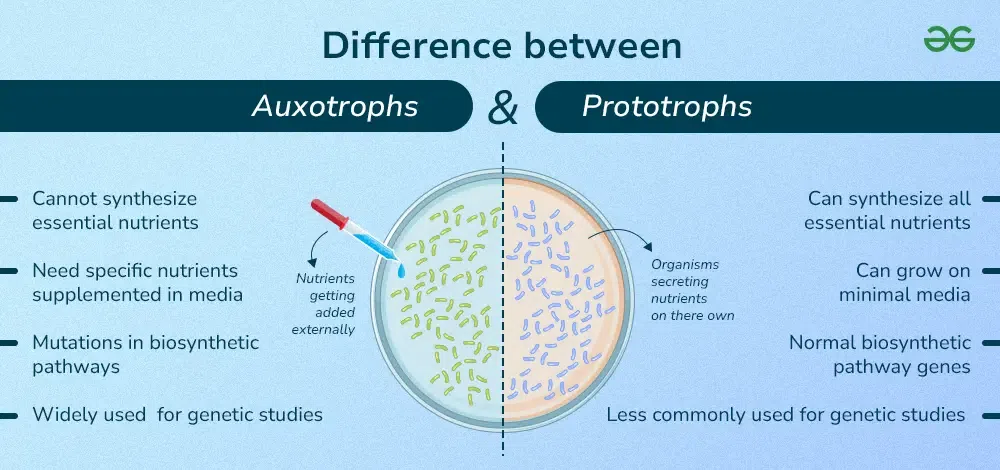Difference Between Auxotrophs and Prototrophs
Last Updated :
07 May, 2024
The difference between auxotrophs and prototrophs lies in their ability to synthesize essential nutrients. Auxotrophs are unable to produce certain vital compounds on their own, whereas prototrophs can synthesize all necessary nutrients independently. Auxotrophs and prototrophs are terms used in microbiology to describe the nutritional requirements of microorganisms. In this article, we will read about the difference between auxotrophs and prototrophs and their similarities in detail.

What are Auxotrophs?
The auxotrophs are microbes that have lost the ability to synthesize one or more essential nutrients due to mutations or genetic alterations. As a result, auxotrophs require supplementation with the specific nutrients or growth factors that they cannot produce independently. For example, an auxotrophic strain lacking the ability to synthesize the amino acid leucine will require leucine supplementation for the growth on the minimal media.
What are Prototrophs?
The prototrophs are microbes capable of synthesizing all essential nutrients required for their growth and survival. They possess functional biosynthetic pathways for the synthesizing amino acids, nucleotides, vitamins and other essential metabolites. As a result prototrophs can grow on the minimal media containing only inorganic salts a carbon source and water. These microbes are often used as the standard reference in the genetic studies and laboratory experiments.
Difference Between Auxotrophs and Prototrophs
The differences between Auxotrophs and prototrophs are:
|
Characteristics
|
Auxotrophs
|
Prototrophs
|
|
Nutritional Dependency
|
Required specific nutrients for growth
|
Can synthesize all essential nutrients internally
|
|
Growth on Minimal Media
|
Require supplemented media for growth
|
Can grow on minimal media without supplementation
|
|
Genetic Mutation
|
Mutation in biosynthetic pathway genes
|
Normal alleles of the biosynthetic pathway genes
|
|
Laboratory Use
|
The widely used for the genetic studies and mutant isolation
|
The less commonly used in genetic studies
|
|
Nutrient requirements
|
Require specific nutrients to grow
|
Do not require specific nutrients
|
|
Examples
|
Mutant strains and genetic knockouts
|
Wild type strains and standard species
|
Similarities Between Auxotrophs and Prototrophs
Some of the similarities between Auxotrophs and Prototrophs are:
- Both are living organisms: Auxotrophs and prototrophs are both alive and require certain things to survive and grow.
- Basic needs overlap: They share essential needs for basic building blocks like water, minerals, and an energy source.
- Cellular machinery: Both possess the necessary cellular machinery to carry out fundamental life processes like metabolism and reproduction.
- DNA and genetics: They share the same genetic blueprint as their parent organism, with the exception of specific mutations in auxotrophs.
- Potential for adaptation: Both can potentially adapt to changing environments, though auxotrophs might face additional challenges due to their specific requirements.
Conclusion – Difference Between Auxotrophs and Prototrophs
In summary, the difference between the auxotrophs and prototrophs lies in their nutritional requirements and genetic characteristics. While prototrophs are self-sufficient in nutrient synthesis auxotrophs depend on external supplementation. Understanding these differences is essential for the various applications ranging from the basic research to the industrial biotechnology and medical microbiology.
Other Related Difference Between Articles
FAQs on Difference Between Auxotrophs and Prototrophs
What are Auxotrophs and Example?
Auxotrophs are organisms unable to synthesize certain essential nutrients, requiring them from the environment. Example: Amino acid auxotrophs of E. coli.
What is the Difference Between an Autotroph and a Prototroph?
The difference between an autotroph and a prototroph lies in their ability to produce all essential nutrients internally. Autotrophs can make their own organic compounds, while prototrophs can synthesize essential nutrients.
What is the Concept of a Prototroph?
The concept of a prototroph refers to organisms capable of synthesizing all essential nutrients needed for growth and reproduction independently, unlike auxotrophs which require specific nutrients from the environment.
Why are Auxotrophs Important in Genetic Studies?
The Auxotrophs allow the researchers to pinpoint specific genes and pathways involved in the biosynthesis by observing the growth patterns of mutants with the different nutritional requirements.
Can Auxotrophs Grow Without the Required Nutrient Provided Externally?
No, auxotrophs cannot grow without the specific nutrient they are deficient in the unless it is supplied externally.
Are Prototrophs More Adaptable to Changing Environments than Auxotrophs?
yes, Prototrophs can synthesize their essential compounds providing an advantage in the environments where specific nutrients might be scarce.
Share your thoughts in the comments
Please Login to comment...